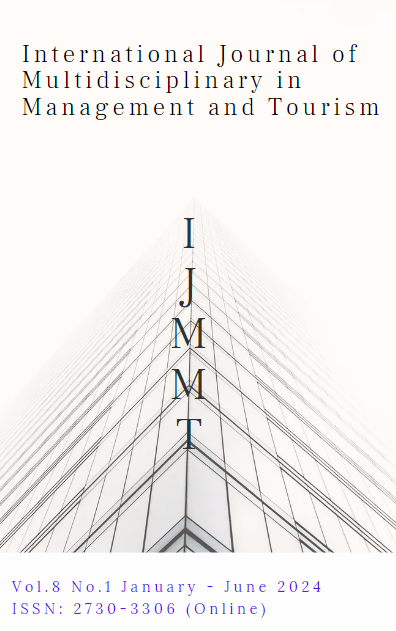Exploration of Chinese Novice Teachers' Teaching Practices and Questioning in Teaching English Reading Classes
Main Article Content
Abstract
This article aimed to study (1) explore Chinese novice English teachers' teaching practices in English reading comprehension classes (2) analyze the types of questions used by Chinese novice English teachers in English reading comprehension classes, the sample was five novice teachers from Yunnan Province, China. They were selected by purposive sampling method from the research population of 22 teachers. the instrument for collecting data was classroom observation checklists of 10 lessons of, 5 lesson plans and 5 teacher journals. Analysis data by Descriptive statistics and Content Analysis. The research results were found as follows;
1. In teaching practices, Chinese novice English teachers clearly communicated their teaching objectives, effectively focused on reading content, teaching resources, and had strong reflective abilities. However, deficiencies were found in diversifying teaching methods, teacher-student interaction, extended and independent learning.
2. Chinese novice English teachers used a high proportion of low-level cognitive questions (PCT=76%) and a lack of attention to high-level cognitive questions (PCT=34%). The PCT of each cognitive level was: Remember (40%); Understand (31%); Analyze (11%); Evaluate (10%); Apply (5%); Create (3%).
Article Details

This work is licensed under a Creative Commons Attribution-NonCommercial-NoDerivatives 4.0 International License.
References
Aebersold, J. A. (2006). From reader to reading teacher. Cambridge University Press.
Allwright, R. L. (1984). The importance of interaction in classroom language learning. Applied Linguistics, 5, 156-171.
Almeida, F. (2018). Strategies to perform a mixed methods study. European Journal of Education Studies, 5(1), 137-151.
Anderson, L. W., Krathwohl, D. R., Airasian, P. W., Cruikshank, K. A., & Wittrock, M. C. (2001). A taxonomy for learning, teaching, and assessing: A revision of Bloom’s taxonomy of educational objectives. Longman.
Anderson, N. J. (2009). Exploring second language: issues and strategies. Heinle & Heinle Publishers.
Bloom, B. S., & Krathwohl, D. R. (1956). Taxonomy of educational objectives: The classification of educational goals, by a committee of college and university examiners. handbook I: cognitive domain. Longmans.
Brown, H. D. (2013). Principles of language learning and teaching. Prentice Hall.
Chen, Y. (2016). Teacher questioning and the cultivation of learners' critical thinking abilities. Foreign Languages and Foreign Language Teaching, (2), 87-96.
Cotton, K. (1988). Classroom questioning. School Improvement Research Series, 5, 1-22.
Ellis, R. (1999). The Study of second language acquisition. Shanghai Foreign Language Education Press.
Freiberge, J. H. (1987). Teacher self-evaluation and principal supervision. NASSP Bulletin, 79(498), 85-92.
Grabe, W., & Stroller, F. L. (2000). Teaching and researching reading. Person Education.
Huang, L., & Chen, L. (2016). The analysis of cognitive orientation of English class questioning in junior high school. Basic Foreign Language Education, 2, 18-26.
Huang, Q., & Zhang, S. (2018). Fostering critical thinking in the English reading classroom through effective questioning. Foreign Language Teaching and Research, 43(1), 56-68.
Hunkins, F. P. (1995). Teaching thinking through effective questioning. Christopher Gordon Publishers.
Li, H. (2017). The significance of vocabulary in language expression. International Journal of Linguistics, 32(4), 567-582.
Li, J. (2019). Cultivating students' thinking qualities through English classroom teacher questioning. Chinese Journal of Education, (A01), 110-112.
Liao, M. L., & Lian, R. (2002). Research on Achievement Goal Orientation and Personality Traits of Novice-Experienced-Expert Teachers. Applied Psychology, (04), 41-46.
Lin, X. H. (2010). A Preliminary Exploration of Teaching Models in High School English Reading Classes. Waiguojiaoyan, (6), 41-43.
Long, M., & Sato, C. (1983). Classroom foreigner talk discourse: forms and functions of teachers’ questions. In H. Seliger, & M. Long (Eds.). Classroom-oriented research in second language acquisition (pp. 268-286). Newsbury House.
Lu, J. G. (2010). How to teach a good reading class - starting from a high school English quality class competition. Jichu Yingyu Jiaoyu.
Ma, X. (2009). The skills of teacher’s questioning in English classes. International Education Studies, 1(4), 92-100.
Margutti, P. (2006). Are you human beings? Order and knowledge construction through questioning in primary classroom interaction. Linguistics and Education, 17(4), 313-346.
Palmer, D. J., Stough, L. M., Burdenski, T. K., & Gonzales, M. (2005). Identifying teacher expertise: An examination of researchers' decision making. Educational Psychologist, 40(1), 13-25.
Quan, L. (2002). The current situation and analysis of questioning in middle school teachers' classrooms. Modern Primary and Secondary Education, 10, 24-25.
Ran, A. H. (2018). Analysis of teaching methods in higher vocational English reading. Journal of Academic and Educational Materials, 10, 230-231.
Swain, M. (1985). Communicative competence: Some roles of comprehensible input and comprehensible output in its development. Input in second language acquisition, 15, 165-179.
Tang, H. (2018). Exploration of a hierarchical model of questioning in junior high school English reading teaching. English Teachers, 18(04), 150-154.
Van Dijk, T. A., & Kintch, W. (1978). Cognitive Psychology and Discourse. de Gruyter.
Wang, M. (2018). The role of grammar in effective communication. Journal of Language Studies, 45(2), 123-145.
Wang, Q. (2006). English teaching methods course. Higher Education Press.
Wu, X. M. (2013). A study on teacher classroom questioning in English reading teaching. Teaching and Management, 06, 73-75.
Wu, Y. A. (2008). Inquiry into the professional development of foreign language teachers. Foreign Language Research, 03, 29-38.
Xia, G. (2018). Analysis of Thinking Qualities as a Key Competency of English. Journal of Minzu Normal University of Xingyi, (3), 84-87.
Xu, R. C., Dong, Y., & Lu, L. J. (2015). Analysis of novice teachers' TPACK knowledge structure based on the nine-factor model. Modern Distance Education Research, (01), 98-105.
Xu, S. G. (2007). Guidance on education and teaching skills for novice teachers. Jilin University Press.
Xu, Z. (2019). Cultivation of high-level thinking ability in high school English. Foreign Language Teaching in Primary and Secondary Schools (Secondary), (3), 50-54.
Zhang, G. W. (2016). Designing comprehension questions for junior high school English reading. Teaching Foreign Languages in Schools, 20(5), 67-78.
Zhang, Y. (2018). Questioning strategies in high school English reading class based on the cultivation of thinking skills. English Illustrated, (28), 34-35.
Zhuang, Q. F. (2018). Issues and strategies in English reading teaching. knowledge-power. Ludong University.

